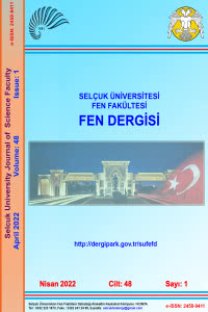EVALUATION OF SENTINEL-2 MSI DATA FOR LAND USE / LAND COVER CLASSIFICATION USING DIFFERENT VEGETATION INDICES
Farklı Bitki Endeksleri Kullanarak Arazi Kullanımı/ Arazi Sınıflandırması İçin SENTINEL-2 MSI Verilerinin Değerlendirilmesi
___
Bektas Balcik, F., Karakacan Kuzucu, A., 2016, “Determination of Land Cover/Land Use Using SPOT 7 Data With Supervised Classification Methods”, GeoAdvances Workshop, Istanbul.Bektas Balcik, F., 2014, “Determining the Impact of Urban Components on Land Surface Temperature of Istanbul by using Remote Sensing Indices”, Environmental Monitoring and Assessment, Vol. 186, pp. 859-872.
Drusch, M., Del Bello, U., Carlier, S., Colin, O., Fernandez, V., Gascon, F., Hoersch, B., Isola, C., Laberinti, P., Martimort, P., Meygret, A., Spoto, F., Sy, O., Marchese, F., Bargellini, P., 2012, “Sentinel-2: ESA’s Optical High-Resolution Mission for GMES Operational Services”, Remote Sensing of Environment, Vol. 120, pp. 25–36.
Esetlili, T., Bektaş Balçık, F., Balı,k Şanlı, F., Üstüner, M., Kalkan, K., Göksel, Ç., Gazioğlu, C., Kurucu Y., 2018, “Comparison of Object and Pixel-Based Classifications for Mapping Crops Using Rapideye Imagery: A Case Study of Menemen Plain, Turkey”, International Journal of Environment and Geoinformatics (IJEGEO), Vol. 5(2), pp. 231- 243.
Foody, G.M., 2002, “Status of Land Cover Classification Accuracy Assessment”, Remote Sensing of Environment, Vol. 80, pp. 185– 201.
Gong, P., 2002, Remote Sensing and Image Analysis Textbook, http://nature.berkeley.edu/~penggong/textbo ok/chapter7/html/sect73.htm.
İrfanoğlu, F., Bektaş Balçık, F., 2018, “Determination of LULC Categories using Object Based Classification and Sentinel-2 MSI data (In Turkish)”, UZALCBS, Eskisehir, Turkiye.
Lu, D., Weng, Q., 2007, “A Survey of Image Classification Methods And Techniques For Improving Classification Performance”, International Journal of Remote Sensing, Vol. 28 (5), pp. 823–870.
Liu, J. G., Mason, P. J., 2009, Essential Image Processing and GIS for Remote Sensing, John Wiley Sons, Inc.
Kahya, C., Bektaş Balçık, F., Öztaner Y. B., Ozcomak D., Seker, D.Z., 2017, “Spatio Temporal Analysis of PM 2.5 Over Marmara Region, Turkey”, Fresenius Environmental Bulletin, Vol. 26,1, pp. 310-317.
Topaloğlu, H., Sertel, E., Musaoğlu, N., 2016, “Assessment of Classification Accuracies of Sentinel-2 and Landsat-8 Data For Land Cover / Use Mapping”, The International Archives of the Photogrammetry, Remote Sensing and Spatial Information Sciences, Volume XLI-B8, 2016 XXIII ISPRS Congress, Prague, Czech Republic.
- ISSN: 2147-9364
- Yayın Aralığı: 2
- Başlangıç: 2013
- Yayıncı: Selçuk Üniversitesi Mühendislik Fakültesi
INDOOR SURVEYING WITH TERRESTRIAL PHOTOGRAMMETRY: A CASE STUDY FOR SIRCALI MASJID
Lütfiye KARASAKA, HAKAN KARABÖRK, HASAN BİLGEHAN MAKİNECİ, Atiye ONURLU, Gizem İŞLER
DEVELOPMENT OF 3D WEB GIS APPLICATION WITH OPEN SOURCE LIBRARY
MUHAMMED OĞUZHAN METE, DOĞUŞ GÜLER, Tahsin YOMRALIOĞLU
TOPSIS VE VIKOR Çok Ölçütlü Karar Analizlerinin Karşılaştırılması
İç Anadolu Bölgesinde Mühendislik ve CBS Amaçlı Quasi-Geoid Belirlenmesi
Fariz MİKAİLSOY, Fatih SARI, Ekrem TUŞAT, Muzaffer KAHVECİ, Ferruh YILDIZ
Yol Eşlemesi İçin Kıvrımlılık Aralıklarının Belirlenmesinde Varyansın Kullanımı
USAGE OF VARIANCE IN DETERMINATION OF SINUOSITY INTERVALS FOR ROAD MATCHING
COMPARISON OF TOPSIS AND VIKOR MULTI CRITERIA DECISION ANALYSIS TECHNIQUES
Mehri RAHIMI, Farhad HOSSEINALI
DETERMINATION OF LOCAL QUASI-GEOID IN CENTRAL ANATOLIA FOR ENGINEERING AND GIS PURPOSE
MUZAFFER KAHVECİ, EKREM TUŞAT, Ferruh YILDIZ, FATİH SARI, FARİZ MİKAİLSOY
